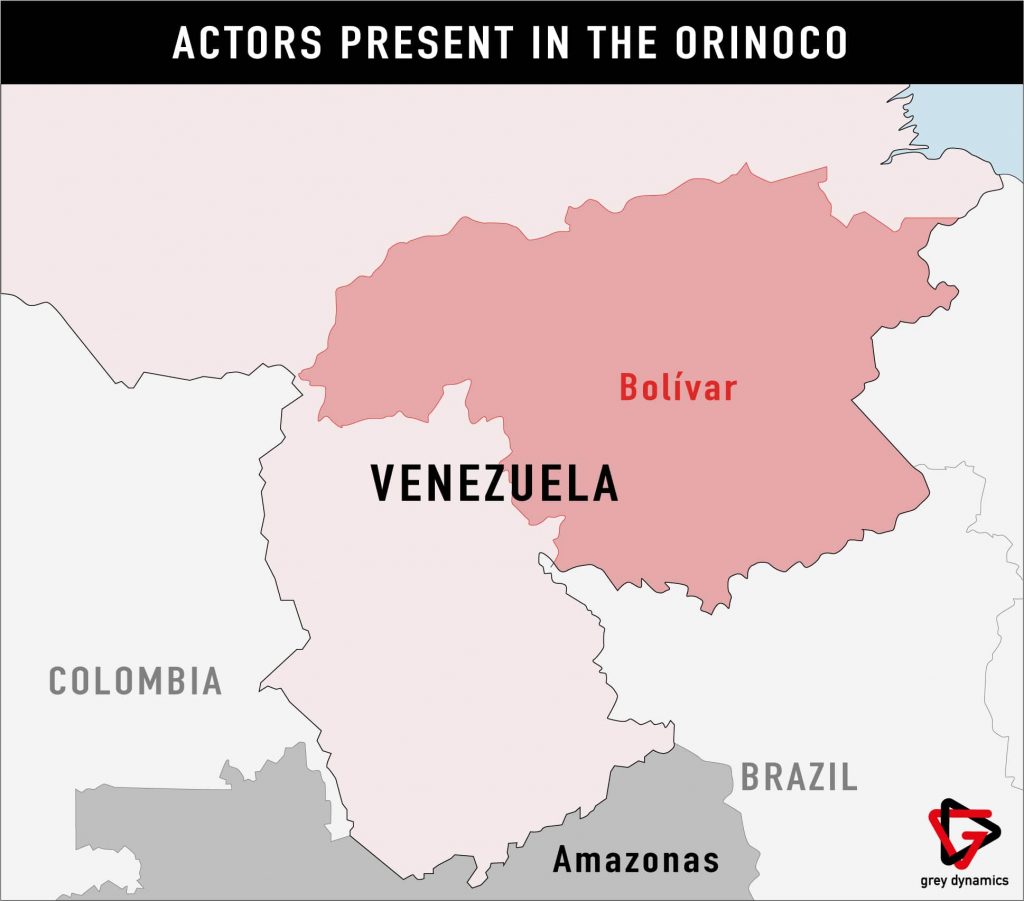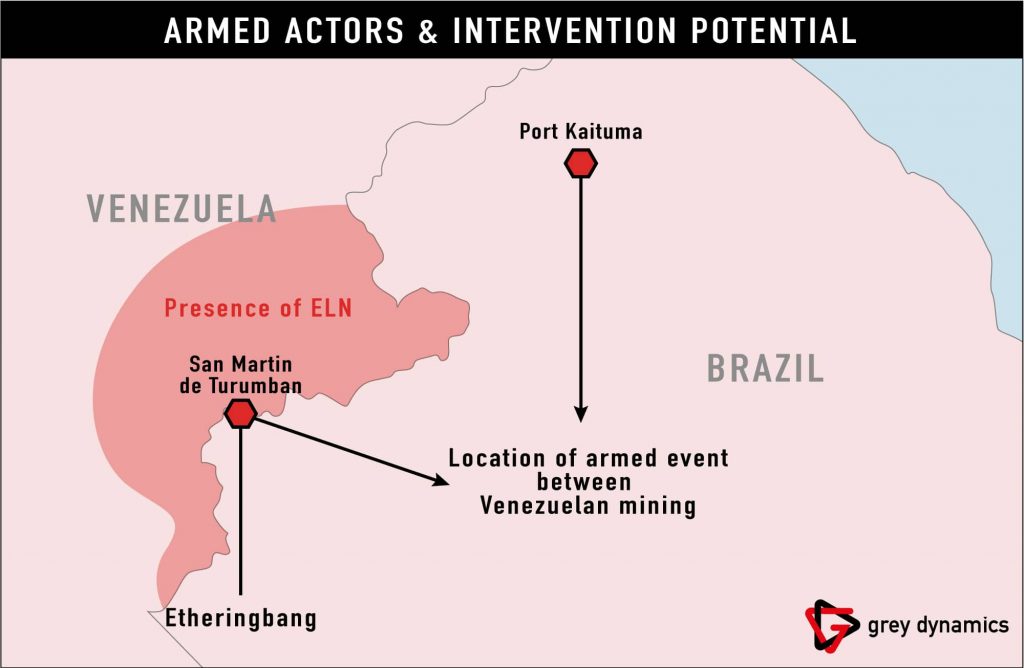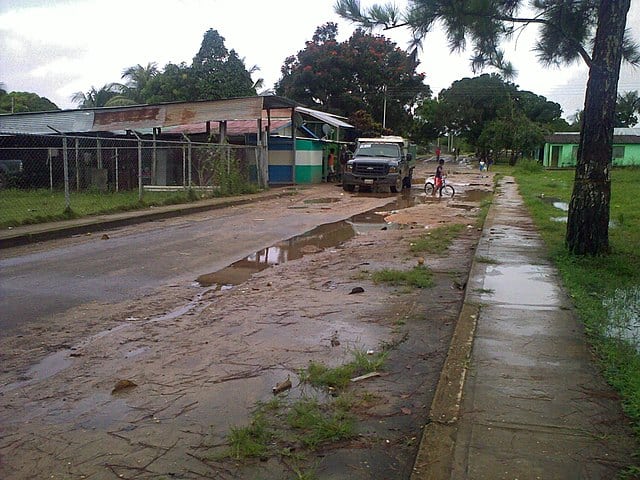The Stability of Venezuelan Mines: Importance
It was reported, according to the UN mission, that indigenous communities in the Bolívar and Amazonas region suffered systematic abuses from non-state and governmental actors. The presence of Russian actors in the south of the country, together with foreign investment, places the control of the Amazonian region of Venezuela as a necessity for the government of Maduro. The stability of Venezuelan mines and surrounding communities create potential scenarios:
- Venezuelan forces are likely to intervene should armed conflict in the Amazonian region threaten foreign investments. The stability of Venezuelan mines likely matters more to foreign operational capability than the ability to counter criminal actors. Foreign support is crucial to counter and survive the blockade of the international community led by the US.
- It is likely that FANB forces, including FAES, do not have the capability to effectively reduce an armed conflict in Amazonas and Bolívar. Events in Apure and Caracas suggest that the state’s armed forces have limited capability in COIN operations with multiple armed actors.
- The range of criminal actors in the Amazonia makes it likely that an intra-criminal conflict will occur with the same probability as a criminal-state conflict. Although confrontations are sporadic, contradicting interests make it unlikely that armed actors, indigenous communities and state actors will continue the permanent low-intensity conflict.
Background

The states of Amazonas and Bolivar are home to large amounts of natural resources, in particular minerals and gold. Deputy Américo De Grazia denounced the abandonment by the government to control the Orinoco Mining Arc, citing the harassment towards indigenous populations and presence of criminal activity. Protests in Brazil regarding the harassment of indigenous communities by illegal miners establish a likely proliferation of criminal actors seeking to profit off governmental inaction. The degree of stability of Venezuelan mines, apart from driving non-state actor activity, attracts foreign investors crucial to the survival of Maduro.
The Venezuelan government granted part of the control of natural resources to foreign actors. China owns an energy production facility in the biggest deposit of thorium in Venezuela. The Central Bank of Venezuela (BCV) since 2018 exports gold through Turkey instead of Switzerland as an alternative to improve Venezuela’s financial limitations. Russian military personnel reported in Canaima in December 2019 protected mineral deposits of interest to the Russian government. The fragility of the Venezuelan state is evident, with FARC and criminal organisations successfully deterring Venezuelan forces since April. The dependency on foreign support is partly driven by the capacity of states to extract natural resources. This makes the stability of Venezuelan mines of highly likely importance.
Indigenous Communities
In the state of Bolívar there are 4 major indigenous groups, the Pemones, Yekuana, Sanemá and the Piaroas. In the state of Amazonas there are 3 major actors, the Yanomami, Ye’kwana and Sanemá. Demarcated areas for indigenous communities are a minority in comparison to undeclared geographical spaces, increasing the likelihood of a conflict of interests between armed or illegal actors and communities.
ELN & FARC

Apart from the attraction of the Colombian-Venezuelan border, FARC and ELN have an established presence in the southern departments of Venezuela. In combination with drug trafficking, profits of illegal gold mining in 2019 sustained 50% of illicit income to FARC factions. The region of southern Venezuela presented in 2019 60% of the illicit income of the ELN. Instead of Venezuelan soil acting as a safe-haven to conduct operations, the economic importance of the region likely fuels an increase in presence and diversification towards other funding means.
Unfortunately for the stability of Venezuelan mines, both groups are established in the Amazonian region of the country. In the state of Amazonas, FARC factions operate in southern Amazonas, while ELN factions dominate the north of the state. In Bolivar, only the ELN is reportedly capable of establishing an east-west corridor through mining regions. The corridors run from northern Amazonas towards Sifontes through two directions, one bordering the northern part of Bolívar and one bordering the southern part until meeting in Sifontes, past El Callao.
With the ELN numbering 2,500 members and FARC factions 3,000 in total as of 2019, it is likely that numbers in Venezuela are smaller. In particular, considering the death of Santrich in May 2021, a historic leader of the FARC, and the presence of only some factions like the Acácio Medina front in the Amazonas state. Still, considering the almost inexistent armed resistance, the capabilities of both groups are highly likely sufficient to continue to expand in the southern region.
Indigenous Communities Under Threat
A conflict of interests is an opportunity to decrease the stability of Venezuela’s mines and mining region. Since 2016, there are 5,000 members of indigenous communities forced to displace to Brazil, although violence from illegal miners places communities in a similar environment. In September 2020, communities in Amazonas rejected the FARC front of Acácio Medina and deterred illegal mining by confiscating machinery. In February, communities accused illegal miners of attempting to expropriate the region and demanded protection from the Pemone community. Ethnic communities are almost certainly targeted by armed actors, whether for inexpensive labour or extortion. With the UN report lacking resources and not documenting indigenous rights violations by state and non-state actors, the humanitarian emergency will likely continue to increase.
Threats to Governmental Stability
Current assessments are likely to place the stability of Venezuela’s mines as less crucial to state survival than FARC rebels in Apure or mega-bandas in Caracas. Nevertheless, the environment in southern Venezuela likely holds the potential to challenge foreign support to Venezuela. The presence of Russian troops in Canaima suggests at least an expectation of Russian assets to be under threat from theft, similar to Wagner personnel deployed to secure Rosneft assets and documents in the Caracas headquarters. While threats towards foreign actors seem unlikely, the degree of governmental control in the southern region is also highly likely minimal. As a consequence, a potential but unlikely targeting of foreign actors would likely push foreign investment out of Venezuela and incursion of Venezuelan armed forces into mining territory.
While foreign investment is crucial, armed actors are likely to cause a disruption in the flow of minerals outside of Venezuela. The stability of Venezuelan mines likely depends on the willingness and intentions of FARC and ELN factions to clash with communities and each other to increase profits. According to NGO Fundaredes, the conflict in Apure between FARC dissidents and state forces trickled to Amazonas and Zulia where armed actors are confronting indigenous communities. Apart from making a state intervention by the armed forces likely, an expansion towards mineral-rich regions creates an opportunity for indigenous communities and armed actors to clash between and within each other. Whatever the outcome of the potential conflict, violence is likely going to increase in both Bolívar and Amazonas in the following 6 months.
Intelligence Cutoff Date: 30th of June 2021 (UTC -7)


